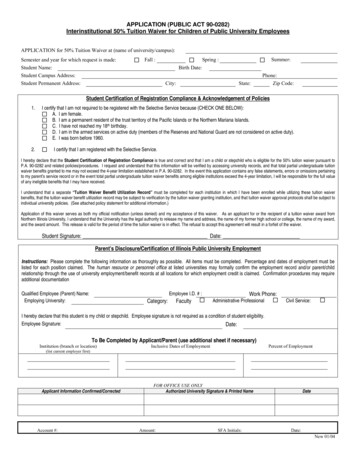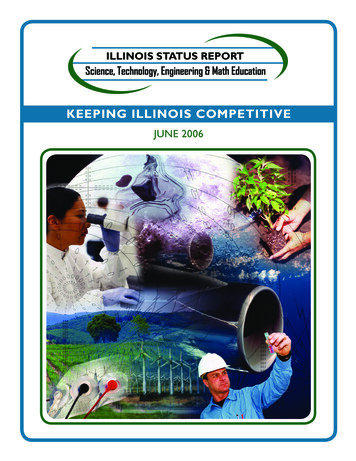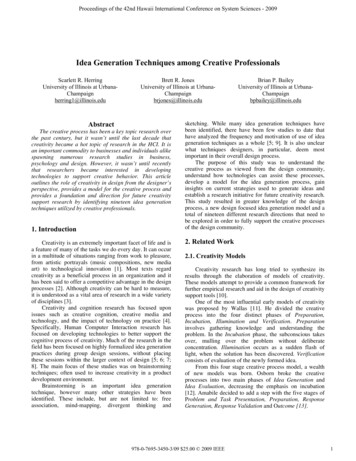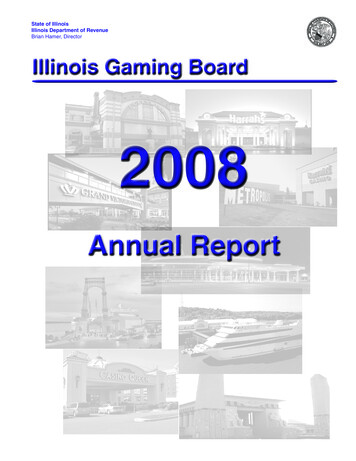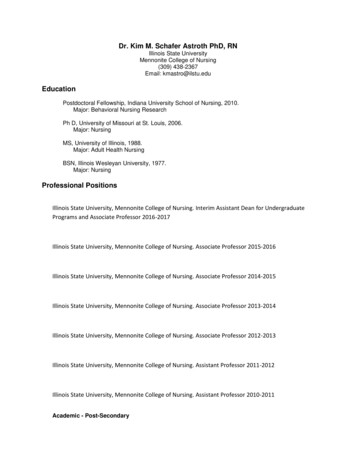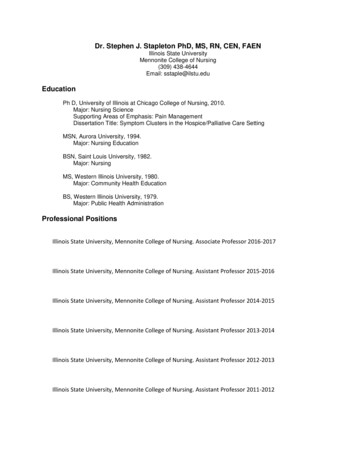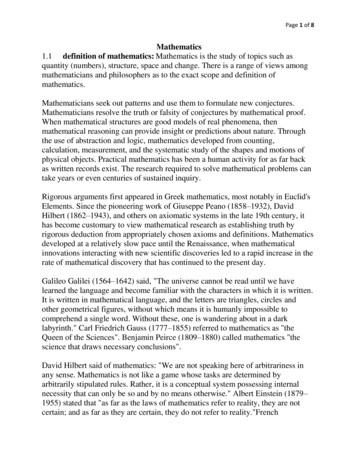
Transcription
Mathematics LearningMATHEMATICS – Pre-KGOAL 6 - Demonstrate and apply a knowledge and sense of numbers, including numeration andoperations.LEARNING STANDARD 6.A Demonstrate beginning understanding of numbers, number names,and nt with understanding and recognize “how many” in small sets up to 5.Connect numbers to quantities they represent using physical models andinformal representations.Differentiate numerals from letters and recognize some single-digit writtennumerals.Verbally recite numbers from 1 to 10.Example Performance DescriptorsExploringDevelopingBuildingRecognize how many thereRecognize how many thereRecognize how many there are in are in sets of 4 and 5 whenare in a set of 1 or 2 withouta set of 3 without counting them presented in a nonlinear,counting them (e.g., one car(e.g., three yellow beads).organized fashion (like a dieor two blue crayons).face).Point to or move objects whenPoint to or move objectsPoint to or move each objectcounting out loud withoutaround as though to organizeto make sure each is countedeffectively tracking itemswithout necessarily countingonce and only once whencounted (may skip items or countout loud.counting in sets up to 5.items more than once).Confuse numerals and letters, Say number names whensaying number namespointing to numerals (but notCorrectly identify theoccasionally when pointing to letters), even ifnumerals 1, 2, and 3.letters.they don’t match.Recite counting words from 1-10,with 2-4 errors (e.g., skipnumbers, mix up order) but also Recite counting words inSay some counting wordssome number names in words in order from 1-10 (with anwhen “counting.”consecutive order (e.g., “one,occasional error).two, five, four, six, seven, nine,ten”).GOAL 7 - Explore measurement of objects and quantities.
LEARNING STANDARD 7.A Measure objects and quantities using direct comparison methodsand nonstandard units.Benchmarks7.A.ECcUse vocabulary that describes and compares length, height, weight,capacity, and size.Example Performance DescriptorsExploringDevelopingBuildingUse a wider appropriateUse appropriate vocabularyvocabulary when makingUse appropriate vocabularywhen making measurements, measurements, such aswhen making measurements,such as “small”, “big”, “short”, “small”, “big”, “short”, “tall”,such as “small”, “big”.“tall”.“empty”, “full”, “heavy”, and“light”.GOAL 8 - Identify and describe common attributes, patterns, and relationships in objects.LEARNING STANDARD 8.A Explore objects and patterns.Benchmarks8.A.ECbRecognize, duplicate, extend, and create simple patterns in various formats.Example Performance DescriptorsExploringDevelopingAttempt to create a simple A-Brepeating pattern using earlychildhood materials butwithout maintaining therepeating pattern (e.g., makescolored marks on the whiteboard beginning with black,green, black, then adds red,green, black, blue, black).Replicate a simple pattern inmusic following the beat byclapping or tapping footlightly.BuildingCreate a simple A-B-C or A-B-Brepeating pattern usingSuccessfully create a simple A-B classroom objects (e.g., linesrepeating pattern usingup people figure with small,classroom objects (e.g., build a medium, large as thetower of alternating blue and repeating pattern; stringsred cubes).beads on a necklace with oneyellow, two orange in arepeating pattern).Replicate patterns in music by Replicate patterns in music byplaying finger games such as singing repetitive songs such“Open, Shut Them.”as “B-I-N-G-O.”MATHEMATICS – Kindergarten
K.OA.2K.OA.4K.CC.6Make sense of problems and persevere in solving them.Reason abstractly and quantitatively.Construct viable arguments and critique the reasoning of others.Model with mathematics.Use appropriate tools strategically.Attend to precision.Look for and make use of structure.Look for and express regularity in repeated reasoning.Write numbers from 0 to 20. Represent a number of objects with a written numeral 020 (with 0 representing a count of no objects).Count to answer "how many?" questions about as many as 20 things arranged in aline, a rectangular array, or a circle, or as many as 10 things in a scatteredconfiguration; given a number from 1-20, count out that many objects.Compare two numbers between 1 and 10 presented as written numerals.Solve addition and subtraction word problems, and add and subtract within 10, e.g., byusing objects or drawings to represent the problem.For any number from 1 to 9, find the number that makes 10 when added to the givennumber, e.g., by using objects or drawings, and record the answer with a drawing orequation.Identify whether the number of objects in one group is greater than, less than, or equalto the number of objects in another group, e.g., by using matching and countingstrategies. Include groups with up to ten objects.MATHEMATICS – 1st .NBT.2Make sense of problems and persevere in solving them.Reason abstractly and quantitatively.Construct viable arguments and critique the reasoning of others.Model with mathematics.Use appropriate tools strategically.Attend to precision.Look for and make use of structure.Look for and express regularity in repeated reasoning.Use addition and subtraction within 20 to solve word problems involving situations ofadding to, taking from, putting together, taking apart, and comparing, with unknownsin all positions, e.g., by using objects, drawings, and equations with a symbol for theunknown number to represent the problem.Understand the meaning of the equal sign, and determine if equations involvingaddition and subtraction are true or false.Understand that the two digits of a two-digit number represent amounts of tens andones. Understand the following as special cases:
1.NBT.41.NBT.61.MD.3Add within 100, including adding a two-digit number and a one-digit number, andadding a two-digit number and a multiple of 10, using concrete models or drawingsand strategies based on place value, properties of operations, and/or the relationshipbetween addition and subtraction; relate the strategy to a written method and explainthe reasoning used. Understand that in adding two-digit numbers, one adds tens andtens, ones and ones; and sometimes it is necessary to compose a ten.Subtract multiples of 10 in the range 10-90 from multiples of 10 in the range 10-90(positive or zero differences), using concrete models or drawings and strategies basedon place value, properties of operations, and/or the relationship between addition andsubtraction; relate the strategy to a written method and explain the reasoning used.Tell and write time in hours and half-hours using analog and digital clocks.MATHEMATICS – 2nd .OA.42.NBT.52.MD.52.MD.72.MD.82.NBT.9Make sense of problems and persevere in solving them.Reason abstractly and quantitatively.Construct viable arguments and critique the reasoning of others.Model with mathematics.Use appropriate tools strategically.Attend to precision.Look for and make use of structure.Look for and express regularity in repeated reasoning.Use addition and subtraction within 100 to solve one- and two-step word problemsinvolving situations of adding to, taking from, putting together, taking apart, andcomparing, with unknowns in all positions, e.g., by using drawings and equations witha symbol for the unknown number to represent the problem.Fluently add and subtract within 20 using mental strategies. By end of Grade 2, knowfrom memory all sums of two one-digit numbers.Use addition to find the total number of objects arranged in rectangular arrays with upto 5 rows and up to 5 columns; write an equation to express the total as a sum ofequal addends.Fluently add and subtract within 100 using strategies based on place value, propertiesof operations, and/or the relationship between addition and subtraction.Use addition and subtraction within 100 to solve word problems involving lengths thatare given in the same units, e.g., by using drawings (such as drawings of rulers) andequations with a symbol for the unknown number to represent the problem.Tell and write time from analog and digital clocks to the nearest five minutes, usinga.m. and p.m.Solve word problems involving dollar bills, quarters, dimes, nickels, and pennies, using and symbols appropriately.Explain why addition and subtraction strategies work, using place value and theproperties of operations. Explanations may be supported by drawings or objects.
***The mathematics priority standards for third grade are formatted foralignment to the state assessment. Districts can determine priority throughanalysis of student performance and growth data in comparison to the domainpoints and percentages presented below.***MATHEMATICS – 3rd GRADEEligible Evidence Statements3. ly add and subtract within 1000 usingstrategies and algorithms based on place value,properties of operations, and/or the relationshipbetween addition and subtraction.Multiply one-digit whole numbers by multiples of10 in the range 10-90 (e.g., 9 x 80, 5 x 60) usingstrategies based on place value and properties ofoperationsGiven a two-step problem situation with the fouroperations, round the values in the problem, thenuse the rounded values to produce an approximatesolution. Content Scope: 3.OA.8, 3.NBT.1, 3.NBT.2,3.NBT.3Solve two-step word problems using the fouroperations requiring a substantial addition,subtraction, or multiplication step, drawing onknowledge and skills articulated in 3.NBT. ContentScope: 3.OA.8, 3.NBT.2, and 3.NBT.3Solve real world and mathematical problemsinvolving perimeters of polygons requiring asubstantial addition, subtraction, or multiplicationstep, drawing on knowledge and skills articulated in3.NBT. Content Scope: 3.MD.8, 3.NBT.2, and3.NBT.3Use information presented in a scaled bar graph tosolve a two-step “how many more” or “how manyless” problem requiring a substantial addition,subtraction, or multiplication step, drawing onknowledge and skills articulated in 3.NBT. ContentScope: 3.MD.3, 3.NBT.2, and 3.NBT.3Domain # ofDomain %points2-64-12%
, subtract, or multiply to solve a one-step wordproblem involving masses or volumes that are givenin the same units, where a substantial addition,subtraction, or multiplication step is requireddrawing on knowledge and skills articulated in3.NBT, e.g., by using drawings (such as a beakerwith a measurement scale) to represent theproblem. Content Scope: 3.MD.2, 3.NBT.2, and3.NBT.3Understand a fraction 1/b as the quantity formedby 1 part when a whole is partitioned into b equalparts; understand a fraction a/b as the quantityformed by a parts of size 1/b.Understand a fraction as a number on the numberline; represent fractions on a number line diagram.a. Represent a fraction 1/b on a number linediagram by defining the interval from 0 to 1 as thewhole and partitioning it into b equal parts.Recognize that each part has size 1/b and that theendpoint of the part based at 0 locates the number1/b on the number line.b. Represent a fraction a/b on a number linediagram by marking off a lengths 1/b from 0.Recognize that the resulting interval has size a/band that its endpoint locates the number a/b on thenumber line.Explain equivalence of fractions in special cases,and compare fractions by reasoning about theirsize.a. Understand two fractions as equivalent (equal) ifthey are the same size.Explain equivalence of fractions in special cases,and compare fractions by reasoning abouttheir size.b. Understand two fractions as equivalent (equal) ifthey are the same point on a number line.Explain equivalence of fractions in special cases,and compare fractions by reasoning about theirsize.b. Recognize and generate simple equivalentfractions, e.g., 1/2 2/4, 4/6 2/3.5-710-13%
Explain equivalence of fractions in special cases,and compare fractions by reasoning about theirsize.c. Express whole numbers as fractions,3.NF.3cand recognize fractions that are equivalent to wholenumbers. Examples: Express 3 in the form 3 3/1;recognize that 6/1 6; locate 4/4 and 1 at the samepoint of a number line diagram.Explain equivalence of fractions in special cases,and compare fractions by reasoning about theirsize.d. Compare two fractions with the same numeratoror the same denominator by reasoning about their3.NF.3dsize. Recognize that comparisons are valid onlywhen the two fractions refer to the same whole.Record the results of comparisons with the symbols , , or , and justify the conclusions, e.g., by using avisual fraction model.In a contextual situation involving a whole numberand two fractions not equal to a whole number,3.NF.A.Int.1 represent all three numbers on a number linediagram, then choose the fraction closest in valueto the whole number.Interpret products of whole numbers, e.g., interpret5 7 as the total number of objects in 5 groups of 73.OA.1objects each. For example, describe a context inwhich a total number of objects can be expressed as5 7.Interpret whole-number quotients of wholenumbers, e.g., interpret 56 8 as the number ofobjects in each share when 56 objects arepartitioned equally into 8 shares, or as a number3.OA.2of shares when 56 objects are partitioned into equalshares of 8 objects each. For example, describe acontext in which a number of shares or a numberof groups can be expressed as 56 8.Use multiplication within 100 (both factors less thanor equal to 10) to solve word problems in situations3.OA.3-1involving equal groups, arrays, or area, e.g., by usingdrawings and equations with a symbol for theunknown number to represent the problem.Use multiplication within 100 (both factors less than3.OA.3-2or equal to 10) to solve word problems in situations9-1117-21%
*3.Int.1involving measurement quantities other than area,e.g., by using drawings and equations with a symbolfor the unknown number to represent the problem.Use division within 100 (quotients related toproducts having both factors less than or equal to10) to solve word problems in situations involvingequal groups, arrays, or area, e.g., by usingdrawings and equations with a symbol for theunknown number to represent the problem.Use division within 100 (quotients related toproducts having both factors less than or equal to10) to solve word problems in situations involvingmeasurement quantities other than area, e.g., byusing drawings and equations with a symbol for theunknown number to represent the problem.Determine the unknown whole number in amultiplication or division equation relating threewhole numbers. For example, determine theunknown number that makes the equation true ineach of the equations 8 ? 48, 5 3, 6 6 ?.Understand division as an unknown-factorproblem. For example, find 32 8 by finding thenumber that makes 32 when multiplied by 8.Fluently multiply and divide within 25. By end ofGrade 3, know from memory all products of twoone-digit numbers.Fluently multiply and divide within 100. By the endof Grade 3, know from memory all products of twoone-digit numbers.Solve two-step word problems using the fouroperations. Represent these problems usingequations with a letter standing for the unknownquantity. Assess the reasonableness of answersusing mental computation and estimation strategiesincluding rounding.Given a two-step problem situation with the fouroperations, round the values in the problem, thenuse the rounded values to produce an approximatesolution. Content Scope: 3.OA.8, 3.NBT.1, 3.NBT.2,3.NBT.3
MD.3-13.MD.3-33.MD.43.MD.5Solve two-step word problems using the fouroperations requiring a substantial addition,subtraction, or multiplication step, drawing onknowledge and skills articulated in 3.NBT. ContentScope: 3.OA.8, 3.NBT.2, and 3.NBT.3Tell and write time to the nearest minute andmeasure time intervals in minutes.Solve word problems involving addition andsubtraction of time intervals in minutes, e.g., byrepresenting the problem on a number linediagram.Measure and estimate liquid volumes and masses ofobjects using standard units of grams (g), kilograms(kg), and liters (l).Add, subtract, multiply, or divide to solve one-stepword problems involving masses or volumes thatare given in the same units, e.g., by using drawings(such as a beaker with a measurement scale) torepresent the problem.Measure or estimate liquid volumes or masses ofobjects using standard units of grams (g), kilograms(kg), and liters (l), then use the estimated value(s) toestimate the answer to a one-step word problem byusing addition, subtraction, multiplication, ordivision. Content Scope: 3.MD.2Draw a scaled picture graph and a scaled bar graphto represent a data set with several categories. Forexample, draw a bar graph in which each square inthe bar graph might represent 5 pets.Solve a put-together problem using informationpresented in a scaled bar graph, then use the resultto answer a “how many more” or “how many less”problem using information presented in the scaledbar graph. Content Scope: 3.MD.3Generate measurement data by measuring lengthsusing rulers marked with halves and fourths of aninch. Show the data by making a line plot, wherethe horizontal scale is marked off in appropriateunits— whole numbers, halves, or quarters.Recognize area as an attribute of plane figures andunderstand concepts of area measurement.7-1113-21%
.5a. A square with side length 1 unit, called “a unitsquare,” is said to have “one square unit” of area,and can be used to measure area.b. A plane figure which can be covered without gapsor overlaps by n unit squares is said to have an areaof n square units.Measure areas by counting unit squares (square cm,square m, square in, square ft, and improvisedunits).Relate area to the operations of multiplication andaddition.b. Multiply side lengths to find areas of rectangleswith whole-number side lengths in the context ofsolving real-world and mathematical problems.Relate area to the operations of multiplication andaddition.d. Recognize area as additive. Find areas ofrectilinear3 figures by decomposing them into nonoverlapping rectangles and adding the areas of thenon-overlapping parts, applying this technique tosolve real world problems.Solve real world and mathematical problemsinvolving perimeters of polygons, including findingthe perimeter given the side lengths, finding anunknown side length, and exhibiting rectangles withthe same perimeter and different areas or with thesame area and different perimeters.Solve real world and mathematical problemsinvolving perimeters of polygons requiring asubstantial addition, subtraction, or multiplicationstep, drawing on knowledge and skills articulated in3.NBT. Content Scope: 3.MD.8, 3.NBT.2, and3.NBT.3Use information presented in a scaled bar graph tosolve a two-step “how many more” or “how manyless” problem requiring a substantial addition,subtraction, or multiplication step, drawing onknowledge and skills articulated in 3.NBT. ContentScope: 3.MD.3, 3.NBT.2, and 3.NBT.3Add, subtract, or multiply to solve a one-step wordproblem involving masses or volumes that are givenin the same units, where a substantial addition,subtraction, or multiplication step is required
3.C.4-1drawing on knowledge and skills articulated in3.NBT, e.g., by using drawings (such as a beakerwith a measurement scale) to represent theproblem. Content Scope: 3.MD.2, 3.NBT.2, and3.NBT.3Understand that shapes in different categories (e.g.,rhombuses, rectangles, and others) may shareattributes (e.g., having four sides), and that theshared attributes can define a larger category (e.g.,quadrilaterals). Recognize rhombuses, rectangles,and squares as examples of quadrilaterals, anddraw examples of quadrilaterals that do not belongto any of these subcategories.Partition shapes into parts with equal areas. Expressthe area of each part as a unit fraction of thewhole. For example, partition a shape into 4 partswith equal area, and describe the area of each partas 1/4 of the area of the shape.Base explanations/reasoning on the properties ofoperations. Content Scope: Knowledge and skillsarticulated in 3.OA.5Base explanations/reasoning on the properties ofoperations. Content Scope: Knowledge and skillsarticulated in 3.OA.9Base explanations/reasoning on the properties ofoperations. Content Scope: Knowledge and skillsarticulated in 3.MD.7Base explanations/reasoning on the relationshipbetween multiplication and division. Content Scope:Knowledge and skills articulated in 3.OA.6Base arithmetic explanations/reasoning on concretereferents such as diagrams (whether provided inthe prompt or constructed by the student in herresponse), connecting the diagrams to a written(symbolic) method. Content Scope: Knowledge andskills articulated in 3.NF.3b, 3.NF.3dBase explanations/reasoning on concrete referentssuch as diagrams (whether provided in the promptor constructed by the student in her response).Content Scope: Knowledge and skills articulatedin 3.MD.5, 3.MD.6, 3.MD.7Distinguish correct explanation/reasoning from thatwhich is flawed, and – if there is a flaw in the36%1019%
3.C.4-23.C.4-33.C.4-43.C.4-53.C.4-63.C.4-7argument – present corrected reasoning. (Forexample, some flawed ‘student’ reasoningis presented and the task is to correct and improveit.) Content Scope: Knowledge and skills articulatedin 3.OA.5Distinguish correct explanation/reasoning from thatwhich is flawed, and – if there is a flaw in theargument – present corrected reasoning. (Forexample, some flawed ‘student’ reasoningis presented and the task is to correct and improveit.) Content Scope: Knowledge and skills articulatedin 3.OA.6Distinguish correct explanation/reasoning from thatwhich is flawed, and – if there is a flaw in theargument – present corrected reasoning. (Forexample, some flawed ‘student’ reasoningis presented and the task is to correct and improveit.) Content Scope: Knowledge and skills articulatedin 3.OA.8Distinguish correct explanation/reasoning from thatwhich is flawed, and – if there is a flaw in theargument – present corrected reasoning. (Forexample, some flawed ‘student’ reasoningis presented and the task is to correct and improveit.) Content Scope: Knowledge and skills articulatedin 3.NF.3b, 3.NF.3dDistinguish correct explanation/reasoning from thatwhich is flawed, and – if there is a flaw in theargument – present corrected reasoning. (Forexample, some flawed ‘student’ reasoningis presented and the task is to correct and improveit.) Content Scope: Knowledge and skills articulatedin 3.MD.7Distinguish correct explanation/reasoning from thatwhich is flawed, and – if there is a flaw in theargument – present corrected reasoning. (Forexample, some flawed ‘student’ reasoningis presented and the task is to correct and improveit.) Content Scope: Knowledge and skills articulatedin 3.OA.9Distinguish correct explanation/reasoning from thatwhich is flawed, and – if there is a flaw in theargument – present corrected reasoning. (For
3.C.5-13.C.5-23.C.6-13.C.6-23.D.13.D.2example, some flawed ‘student’ reasoningis presented and the task is to correct and improveit.) Content Scope: Knowledge and skills articulatedin 2.NBTPresent solutions to two-step problems in the formof valid chains of reasoning, using symbols such asequals signs appropriately (for example, rubricsaward less than full credit for the presence ofnonsense statements such as 1 4 5 7 12,even if the final answer is correct), or identify ordescribe errors in solutions to two-step problemsand present corrected solutions. Content Scope:Knowledge and skills articulated in 3.OA.8Present solutions to multi-step problems in theform of valid chains of reasoning, using symbolssuch as equals signs appropriately (for example,rubrics award less than full credit for the presenceof nonsense statements such as 1 4 5 7 12,even if the final answer is correct), or identify ordescribe errors in solutions to multi-step problemsand present corrected solutions. Content Scope:Knowledge and skills articulated in 3.MD.7b,3.MD.7dBase explanations/reasoning on a number linediagram (whether provided in the prompt orconstructed by the student in her response).Content scope: Knowledge and skills articulated in3.NF.2Base explanations/reasoning on a number linediagram (whether provided in the prompt orconstructed by the student in her response).Content scope: Knowledge and skills articulatedin 3.MD.1Solve multi-step contextual word problems withdegree of difficulty appropriate to Grade 3,requiring application of knowledge and skillsarticulated in Type I, Sub-Claim A EvidenceStatements.Solve multi-step contextual problems with degreeof difficulty appropriate to Grade 3, requiringapplication of knowledge and skills articulated in2.OA.A, 2.OA.B, 2.NBT, and/or 2.MD.B.Total Number of Points125223%
Note: Evidence Statements with * indicate contentscope across multiple domainsPage Break***The mathematics priority standards for fourth grade are formatted foralignment to the state assessment. Districts can determine priority throughanalysis of student performance and growth data in comparison to the domainpoints and percentages presented below.***MATHEMATICS – 4th GRADEEligible Evidence .NBT.5-14.NBT.5-2Recognize that in a multi-digit wholenumber, a digit in one place represents tentimes what it represents in the place to itsright. For example, recognize that 700 70 10 by applying concepts of place value anddivision.Read and write multi-digit whole numbersusing base-ten numerals, number names,and expanded form. Compare two multi-digitnumbers based on meanings of the digits ineach place, using , , and symbols torecord the results of comparisons.Use place value understanding to roundmulti-digit whole numbers to any place.Fluently add multi-digit whole numbers usingthe standard algorithm.Fluently subtract multi-digit whole numbersusing the standard algorithm.Multiply a whole number of up to four digitsby a one-digit whole number using strategiesbased on place value and the properties ofoperations.Multiply two two-digit numbers, usingstrategies based on place value and theproperties of operations.Domain #Domain %of points5-810-15%
t.4*4.Int.74.NF.1-24.NF.2-14.NF.3a4.NF.3b-1Find whole-number quotients andremainders with three-digit dividends andone-digit divisors, using strategies based onplace value, the properties of operations,and/or the relationship betweenmultiplication and division.Find whole-number quotients andremainders with four-digit dividends andone-digit divisors, using strategies based onplace value, the properties of operations,and/or the relationship betweenmultiplication and division.Perform computations by applyingconceptual understanding of place value,rather than by applying multi-digitalgorithms.Solve one-step word problems involvingmultiplying two two-digit numbers.Solve one-step word problems involvingmultiplying a four-digit number by a onedigit number.Solve one-step word problems involvingdividing a four-digit number by a one-digitnumber.Solve one-step word problems involvingadding or subtracting two four-digitnumbers.Use the principle a/b (nxa)/(nxb) torecognize and generate equivalent fractions.Compare two fractions with differentnumerators and different denominators,e.g., by creating common denominators orby comparing to a benchmark fraction suchas 1/2. Record the results of comparisonswith symbols , , or .Understand a fraction a/b with a 1 as asum of fractions 1/b.a. Understand addition and subtraction offractions as joining and separating partsreferring to the same whole.Understand a fraction a/b with a 1 as asum of fractions 1/b.1019%
4.NF.3c4.NF.3d4.NF.4a4.NF.4b-14.NF.4b-2b. Decompose a fraction into a sum offractions with the same denominator inmore than one way, recording eachdecomposition by an equation. Examples:3/8 1/8 1/8 1/8; 3/8 1/8 2/8; 2 1/8 1 1 1/8 8/8 8/8 1/8.Understand a fraction a/b with a 1 as asum of fractions 1/b.c. Add and subtract mixed numbers with likedenominators, e.g., by replacing each mixednumber with an equivalent fraction, and/orby using properties of operations and therelationship between addition andsubtraction.Understand a fraction a/b with a 1 as a sumof fractions 1/b.d. Solve word problems involving additionand subtraction of fractions referring to thesame whole and having like denominators,e.g., by using visual fraction models andequations to represent the problem.Apply and extend previous understandings ofmultiplication to multiply a fraction by awhole number.a. Understand a fraction a/b as a multiple of1/b. For example, use a visual fraction modelto represent 5/4 as the product 5 x (1/4),recording the conclusion by the equation 5/4 5 x (1/4).Apply and extend previous understandings ofmultiplication to multiply a fraction by awhole number.b. Understand a multiple of a/b as a multipleof 1/b. For example, use a visual fractionmodel to express 3 x (2/5) as 6 x (1/5).Apply and extend previous understandings ofmultiplication to multiply a fraction by awhole number.b. Use the understanding that a multiple ofa/b is a multiple of 1/b to multiply a fractionby a whole number. For example, use avisual fraction model to express 3 x (2/5) as6/5. (In general, n x (a/b) (nxa)/b.)
F.Int.24.OA.1-1Apply and extend previous understandings ofmultiplication to multiply a fraction by awhole number.c. Solve word problems involvingmultiplication of a fraction by a wholenumber, e.g., by using vis
3.NBT, e.g., by using drawings (such as a beaker with a measurement scale) to represent the problem. Content Scope: 3.MD.2, 3.NBT.2, and 3.NBT.3 3.NF.1 Understand a fraction 1/b as the quantity formed by 1 part when a whole is partitioned into b equal parts; understand a fraction a/b as the quantity formed by a parts of size 1/b. 5-7 10-13%
